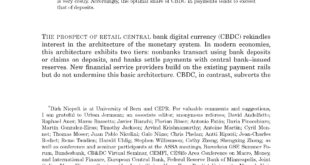Journal of Finance. HTML (local copy). Abstract: We analyze the role of retail central bank digital currency (CBDC) and reserves when banks exert deposit market power and liquidity transformation entails externalities. Optimal monetary architecture minimizes the social costs of liquidity provision and optimal monetary policy follows modified Friedman rules. Interest rates on reserves and CBDC should differ. Calibrations robustly suggest that CBDC provides liquidity more efficiently than...
Read More »A Financial System Built on Bail-Outs?
In a Wall Street Journal opinion piece and an accompanying paper and blog post, John Cochrane and Amit Seru argue that vested interests prevent change towards a simpler, better-working financial system. They describe various “bail-outs” since 2020, in the U.S. financial sector and elsewhere. They point out that in Switzerland, too, the government orchestrated takeover of Credit Suisse by UBS relied on taxpayer support. And they conclude that regulatory measures after the great financial...
Read More »Budgetary Effects of Ageing and Climate Policies in Switzerland
A report by the Federal Finance Administration anticipates lower net revenues for all levels of government. … demographic-related expenditure will increase from 17.2% of gross domestic product (GDP) to 19.8% of GDP by 2060. If no reforms are made, public debt would rise from the current 27% to 48% of GDP. The need for reform is particularly pronounced at federal (including social security) and cantonal level. While AHV expenditure in particular poses a challenge for the Confederation,...
Read More »SNB Annual Report
The SNB has published its annual report. Some highlights from the summary: Climate risks and adjustments to climate policy can trigger or amplify market fluctuations and influence the attractiveness of investments. From an investment perspective, such risks are essentially no different from other financial risks. The SNB manages the risks to its investments by means of its diversification strategy. … A prerequisite for illiquid assets to be used as collateral in obtaining liquidity...
Read More »Banks and Privacy, U.S. vs Canada
JP Koning writes: An interesting side point here is that Canadians don’t forfeit their privacy rights by giving up their personal information to third-parties, like banks. We have a reasonable expectation of privacy with respect to the information we give to our bank, and thus our bank account information is afforded a degree of protection under Section 8 of the Charter. My American readers may find this latter feature odd, given that U.S. law stipulates the opposite, that Americans...
Read More »“Topics in Macroeconomics,” Bern, Spring 2024
BA course at the University of Bern. Time: Monday, 10:15–12:00. Location: H4, 115. Uni Bern’s official course page. The course targets students who have completed their mandatory training in microeconomics, macroeconomics and mathematics and who want to make use of macroeconomic theory in order to analyze questions related to asset prices, bubbles, government debt, or the link between fiscal and monetary policy. The grade may depend on participation in class; small group projects; and/or...
Read More »“Fiscal and Monetary Policies,” Bern, Spring 2024
MA course at the University of Bern. Lecture: Monday, 12.15 – 14.00, UniS A027.Session: Tuesday, 12.15 – 14.00, UniS A017, on 5 Mar, 19 Mar, 26 Mar, 16 Apr, 30 Apr, 14 May. Some lecture and session dates may be swapped. Uni Bern’s official course page. Problem sets and solutions can be found here. The course covers macroeconomic theories of fiscal policy (including tax and debt policy) and the interaction between fiscal and monetary policy. Participants should be familiar with the...
Read More »“Augenwischerei um SNB-Ausschüttungen (Misconceptions about SNB Distributions),” NZZ, 2024
Neue Zürcher Zeitung, January 25, 2024. PDF. HTML. Kritik an der Höhe der SNB-Ausschüttungen ist somit nur gerechtfertigt, wenn die Finanzverantwortlichen von Bund und Kantonen die genannten Hebel nicht in Bewegung setzen können. Einer solchen Kritik muss sich die SNB stellen. Sie hat die Kompetenz, ihre Bilanz nach geldpolitischen Erfordernissen zu gestalten, aber eine mechanische Rückstellungspolitik entspricht diesem Erfordernis kaum. Die SNB sollte daher begründen, warum eine...
Read More »Bank of England CBDC Academic Advisory Group
The Bank of England and HM Treasury have formed a CBDC Academic Advisory Group (AAG). The AAG will bring together a diverse, multi-disciplinary group of experts to encourage academic research, debate and promote discussion on a range of topics, to support the Bank and HM Treasury’s work during the design phase of a digital pound. Members: Alexander Edmund Voorhoeve Professor of Philosophy London School of Economics Alistair Milne Professor of Financial Economics Loughborough University...
Read More »Panel on “Will the digital euro take off?,” CEPR, 2023
Katrin Assenmacher (ECB), Peter Bofinger (U of Wurzburg), Rod Garratt (UCSB, BIS), Alexandre Stervinou (Banque de France). Chair: Dirk Niepelt. One of the opening events at CEPR’s Paris Symposium 2023. Organizer: Tessa Ogden, Dirk Niepelt.
Read More » Dirk Niepelt
Dirk Niepelt

